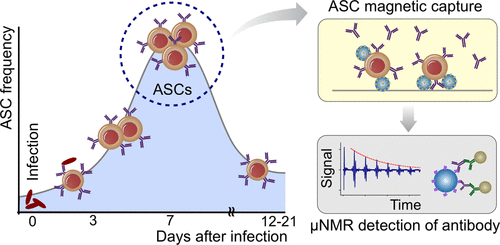Our official English website, www.x-mol.net, welcomes your feedback! (Note: you will need to create a separate account there.)
Nanomagnetic System for Rapid Diagnosis of Acute Infection
ACS Nano ( IF 17.1 ) Pub Date : 2017-11-14 00:00:00 , DOI: 10.1021/acsnano.7b06074 Ki Soo Park 1, 2, 3, 4 , Hoyoung Kim 3, 4, 5 , Soojin Kim 3, 4, 5 , Kyungheon Lee 1, 2 , Sohyeon Park 3, 4, 5 , Jun Song 1 , Changwook Min 1 , Farhana Khanam 6 , Rasheduzzaman Rashu 6 , Taufiqur Rahman Bhuiyan 6 , Edward T. Ryan 7, 8, 9 , Firdausi Qadri 6 , Ralph Weissleder 1, 2, 10 , Jinwoo Cheon 3, 4, 5 , Richelle C. Charles 7, 8 , Hakho Lee 1, 2, 3, 4
ACS Nano ( IF 17.1 ) Pub Date : 2017-11-14 00:00:00 , DOI: 10.1021/acsnano.7b06074 Ki Soo Park 1, 2, 3, 4 , Hoyoung Kim 3, 4, 5 , Soojin Kim 3, 4, 5 , Kyungheon Lee 1, 2 , Sohyeon Park 3, 4, 5 , Jun Song 1 , Changwook Min 1 , Farhana Khanam 6 , Rasheduzzaman Rashu 6 , Taufiqur Rahman Bhuiyan 6 , Edward T. Ryan 7, 8, 9 , Firdausi Qadri 6 , Ralph Weissleder 1, 2, 10 , Jinwoo Cheon 3, 4, 5 , Richelle C. Charles 7, 8 , Hakho Lee 1, 2, 3, 4
Affiliation

|
Pathogen-activated antibody-secreting cells (ASCs) produce and secrete antigen-specific antibodies. ASCs are detectable in the peripheral blood as early as 3 days after antigen exposure, which makes ASCs a potential biomarker for early disease detection. Here, we present a magnetic capture and detection (MCD) assay for sensitive, on-site detection of ASCs. In this approach, ASCs are enriched through magnetic capture, and secreted antibodies are magnetically detected by a miniaturized nuclear magnetic resonance (μNMR) system. This approach is based entirely on magnetics, which supports high contrast against biological background and simplifies assay procedures. We advanced the MCD system by (i) synthesizing magnetic nanoparticles with high magnetic moments for both cell capture and antibody detection, (ii) developing a miniaturized magnetic device for high-yield cell capture, and (iii) optimizing the μNMR assay for antibody detection. Antibody responses targeting hemolysin E (HlyE) can accurately identify individuals with acute enteric fever. As a proof-of-concept, we applied MCD to detect antibodies produced by HlyE-specific hybridoma cells. The MCD achieved high sensitivity in detecting antibodies secreted from as few as 5 hybridoma cells (50 cells/mL). Importantly, the assay could be performed with whole blood with minimal sample processing.
中文翻译:

纳米磁性系统可快速诊断急性感染
病原激活的抗体分泌细胞(ASC)产生并分泌抗原特异性抗体。最早在抗原暴露后3天,就可以在外周血中检测到ASC,这使ASC成为早期疾病检测的潜在生物标记。在这里,我们介绍了用于ASCs的敏感,现场检测的磁捕获和检测(MCD)分析。在这种方法中,ASC通过磁捕获富集,并且分泌的抗体通过微型核磁共振(μNMR)系统进行磁性检测。该方法完全基于磁性,可在生物学背景下提供高对比度,并简化测定程序。我们通过(i)合成具有高磁矩的磁性纳米粒子来进行细胞捕获和抗体检测,从而改进了MCD系统,(ii)开发用于高产量细胞捕获的小型磁性设备,以及(iii)优化用于抗体检测的μNMR分析。针对溶血素E(HlyE)的抗体反应可以准确识别患有急性肠热的个体。作为概念验证,我们将MCD应用于检测HlyE特异性杂交瘤细胞产生的抗体。MCD在检测少至5个杂交瘤细胞(50个细胞/ mL)分泌的抗体时实现了高灵敏度。重要的是,该测定可以用最少的样品处理就可以用全血进行。MCD在检测少至5个杂交瘤细胞(50个细胞/ mL)分泌的抗体时实现了高灵敏度。重要的是,该测定可以用最少的样品处理就可以用全血进行。MCD在检测少至5个杂交瘤细胞(50个细胞/ mL)分泌的抗体时实现了高灵敏度。重要的是,该测定可以用最少的样品处理就可以用全血进行。
更新日期:2017-11-14
中文翻译:

纳米磁性系统可快速诊断急性感染
病原激活的抗体分泌细胞(ASC)产生并分泌抗原特异性抗体。最早在抗原暴露后3天,就可以在外周血中检测到ASC,这使ASC成为早期疾病检测的潜在生物标记。在这里,我们介绍了用于ASCs的敏感,现场检测的磁捕获和检测(MCD)分析。在这种方法中,ASC通过磁捕获富集,并且分泌的抗体通过微型核磁共振(μNMR)系统进行磁性检测。该方法完全基于磁性,可在生物学背景下提供高对比度,并简化测定程序。我们通过(i)合成具有高磁矩的磁性纳米粒子来进行细胞捕获和抗体检测,从而改进了MCD系统,(ii)开发用于高产量细胞捕获的小型磁性设备,以及(iii)优化用于抗体检测的μNMR分析。针对溶血素E(HlyE)的抗体反应可以准确识别患有急性肠热的个体。作为概念验证,我们将MCD应用于检测HlyE特异性杂交瘤细胞产生的抗体。MCD在检测少至5个杂交瘤细胞(50个细胞/ mL)分泌的抗体时实现了高灵敏度。重要的是,该测定可以用最少的样品处理就可以用全血进行。MCD在检测少至5个杂交瘤细胞(50个细胞/ mL)分泌的抗体时实现了高灵敏度。重要的是,该测定可以用最少的样品处理就可以用全血进行。MCD在检测少至5个杂交瘤细胞(50个细胞/ mL)分泌的抗体时实现了高灵敏度。重要的是,该测定可以用最少的样品处理就可以用全血进行。



























 京公网安备 11010802027423号
京公网安备 11010802027423号